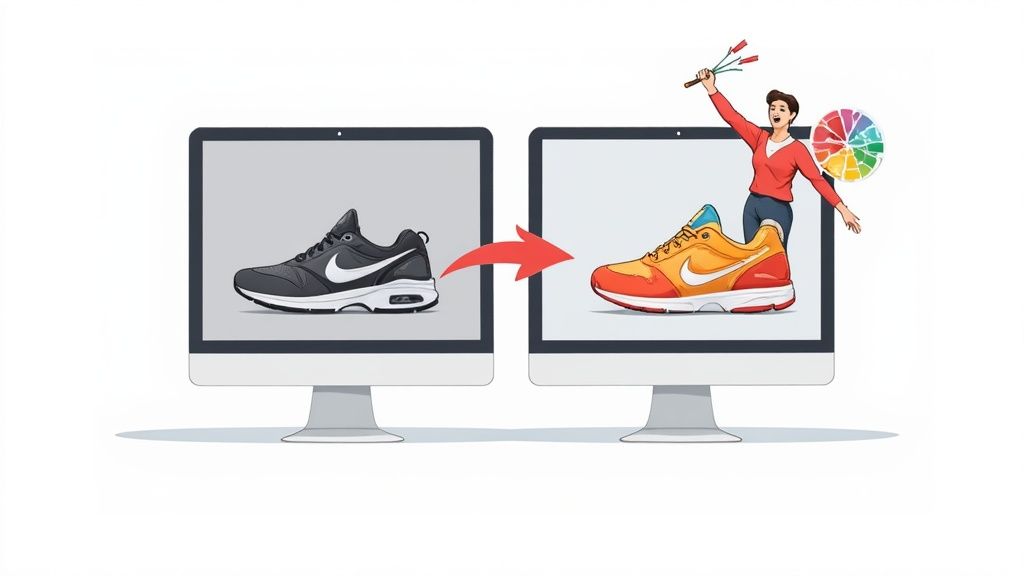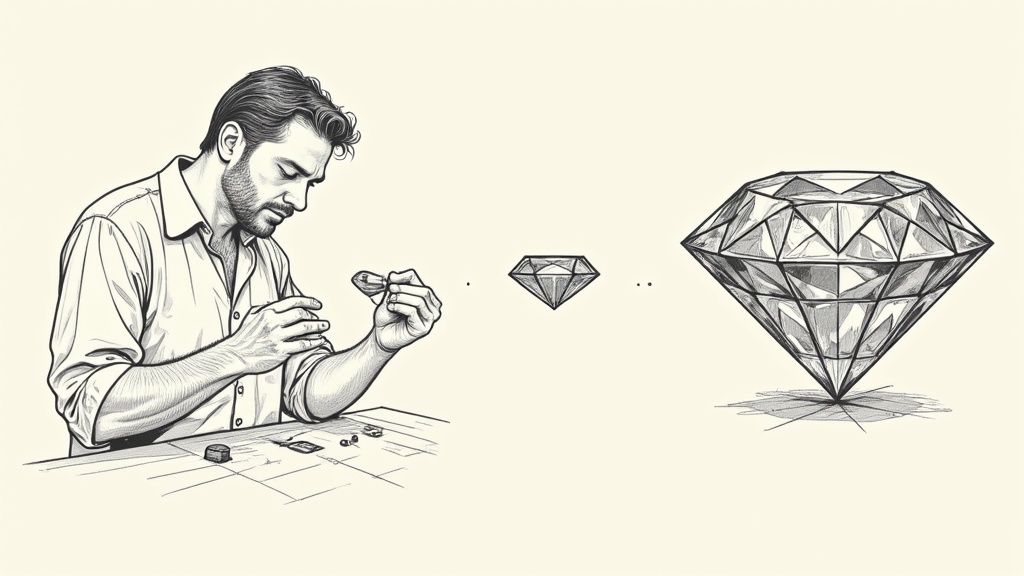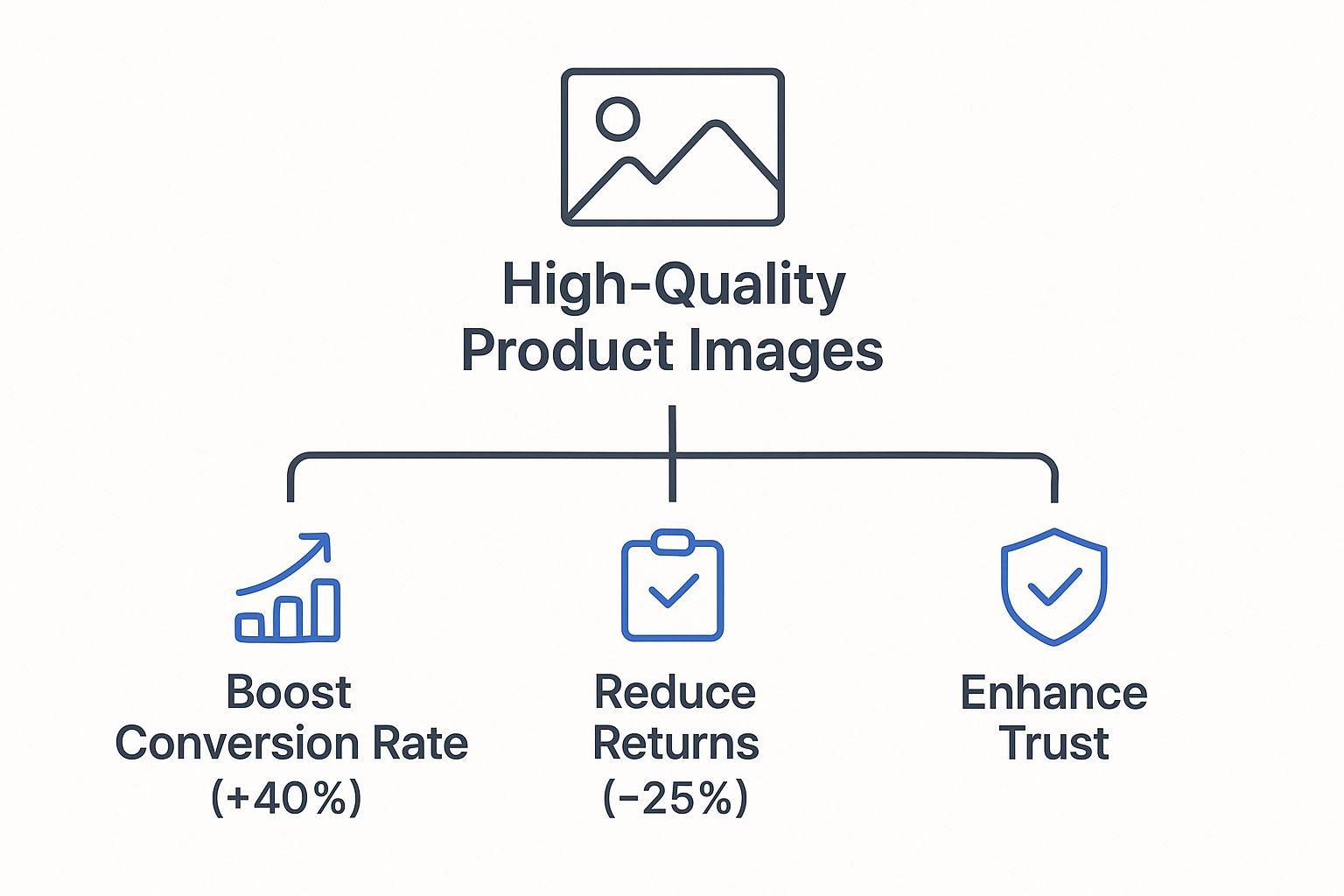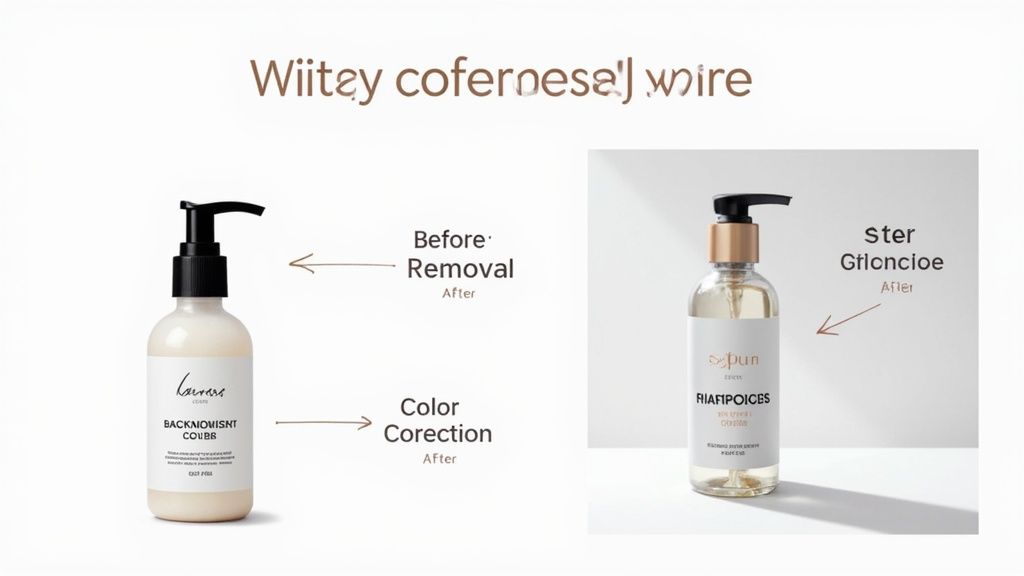Professional Product Image Editing Service | Enhance Your Ecommerce

So, you've taken pictures of your products. What happens next? That raw, unedited photo needs to be transformed into a polished, professional image that's ready to sell online. This is where a product image editing service comes in. It's the essential bridge between snapping a photo and convincing a customer to click "buy."
What Is a Product Image Editing Service

Think of your raw product photos like unpolished diamonds. They have potential, sure, but their real value is locked away behind distracting backgrounds, bad lighting, or inconsistent colors. A product image editing service is the expert craftsman who cuts and polishes those raw shots until they sparkle.
This is a whole lot more than just slapping on an Instagram filter. It's a detailed process that turns a simple snapshot into a high-impact sales asset. In e-commerce, your customers can't touch or hold the product, so the image has to do all the heavy lifting. It needs to convey quality, texture, and trustworthiness all on its own.
It's a Marketing Tool, Not Just a Tech Fix
It’s easy to think of photo editing as just another technical chore on your to-do list. But a professional image editing service is really a marketing partner. The work they do has a direct and immediate impact on how shoppers see your brand.
Every little tweak, whether it's removing a tiny speck of dust or perfectly matching a color, is about building trust and removing any reason for a customer to hesitate. In a crowded online marketplace, even a small visual flaw can plant a seed of doubt. Professional editing gets rid of those distractions, so all the focus is on your product's best features.
A great product photo doesn't just show what you sell; it communicates the quality and care behind your brand. Professional editing is the bridge between a simple picture and a confident customer.
These services use a whole toolkit of specialized techniques to get that perfect finish. We're not talking about automated, one-click fixes, but skilled, manual enhancements.
- Background Removal: This creates a clean, consistent look across your entire product catalog, which makes your online store look instantly more professional.
- Color Correction: This ensures the product's color in the photo is a perfect match to the real thing. Getting this right is crucial for minimizing customer returns.
- Retouching and Enhancement: Experts meticulously remove dust, scratches, fingerprints, and weird reflections to show the product in its absolute best light.
- Shadow and Lighting Adjustments: Adding realistic shadows or balancing the light gives the product depth, making it look more tangible and appealing.
At the end of the day, a product image editing service isn't a cost—it's an investment in your brand's reputation. It elevates your products, builds credibility, and gives you a serious edge in a competitive market.
Why Great Product Images Are Non-Negotiable
In e-commerce, your product photos are your silent salespeople. They're on the clock 24/7, making the first impression on every single person who visits your store. Long before a potential customer reads your carefully crafted product description, they’ve already made a snap judgment based on your images.
That first visual handshake happens in a fraction of a second, and it's incredibly powerful. A crisp, clean, professional photo instantly signals quality and builds trust. On the flip side, a blurry, poorly lit, or inconsistent image can plant a seed of doubt, making shoppers question not just the product, but your entire brand.
This isn't just a hunch; it's how online shopping psychology works. Customers can't touch or feel the product, so they rely entirely on visuals to bridge that gap. Great images give them the confidence to click "buy" by showing them an accurate, and appealing, version of what they'll get.
The Direct Impact on Your Bottom Line
Think of a professional product image editing service not as an expense, but as a direct investment in your store's success. The link between image quality and your most important business metrics is crystal clear. Polished visuals have a ripple effect, influencing everything from click-through rates to sales and even customer satisfaction after the purchase.
For instance, getting the color just right in a photo is a huge deal. When a product arrives looking exactly as it did online, the customer is happy. Professional color correction helps you nail this, which in turn reduces one of the biggest headaches for online sellers: product returns. A clear, well-edited photo sets the right expectations, leading to fewer returns and a healthier profit margin.
This infographic lays out the core benefits of making high-quality product images a top priority.

As you can see, the payoff is huge. Professional images are directly tied to higher conversion rates, a drop in returns, and a solid foundation of customer trust.
Visuals That Convert Hesitation Into Confidence
Imagine a photo with a cluttered, distracting background versus one with a clean, pure white backdrop. The first one makes the shopper work to figure out what they're even looking at. The second one lets your product be the star, showing off its best features without any visual noise.
This same idea applies across all editing techniques:
- Consistency: When all your product photos share the same polished look, it creates a seamless, professional brand experience that feels trustworthy.
- Detail: Good editing can bring out the fine textures, materials, and tiny details that prove your product's quality and justify its price.
- Clarity: Removing tiny specks of dust or smudges ensures the customer sees a perfect version of what they're buying.
Ultimately, these small professional touches build a powerful sense of reliability. You can dig deeper into how these visual tweaks work by improving ecommerce conversion rates in our detailed guide.
The Growing Demand for Professional Polish
Let's face it, everyone has a great camera these days, from the one in their pocket to high-end mirrorless setups. This means businesses are sitting on more raw photos than ever before. But raw isn't ready. This explosion of content has created a massive need for skilled editors who can transform those good shots into commercial-grade assets.
In a crowded online marketplace, your product images are the lighthouse guiding customers to your store. A professional finish ensures that light shines brightly, building immediate trust and driving sales.
The scale of this need is staggering. The global photographic services market, which includes professional editing, was valued at USD 35.78 billion in 2024 and is only expected to climb. This growth points to a simple truth in modern commerce: professional imagery isn't a "nice-to-have" anymore. It's the standard customers expect and the key to turning a casual browser into a loyal fan.
What Can a Product Photo Editing Service Actually Do?
Think of product image editing less as a technical task and more as a set of business tools. Each service on the menu is designed to solve a specific problem that might stop a customer from clicking "buy." When you understand what's possible, you can ask for exactly what you need to boost sales and build a brand that looks the part.

Let's walk through the most common services and see how they directly impact your bottom line.
Key Editing Services and Their Business Impact
The table below breaks down the most requested editing services, explaining what they are in simple terms and, more importantly, what they do for your business.
| Editing Service | Technical Description | Primary Business Benefit |
|---|---|---|
| Background Removal | Isolate the product from its original background, typically placing it on pure white (#FFFFFF). | Creates a clean, consistent look across all product listings, making your store look professional and trustworthy. |
| Color Correction | Adjust hue, saturation, and brightness to ensure the photo's colors perfectly match the physical product. | Reduces returns and builds customer confidence by setting accurate expectations ("what you see is what you get"). |
| Retouching | Digitally remove minor flaws like dust, scratches, fingerprints, or unwanted reflections. | Presents the product in its ideal state, reinforcing its quality and perceived value. |
| Shadow Creation | Add a natural-looking drop shadow or reflection shadow to give the product depth and dimension. | Makes the product look more realistic and tangible, helping customers visualize it in their own space. |
| Ghost Mannequin | Composite multiple images of clothing on a mannequin to create a hollow, 3D effect that shows fit and shape. | Showcases apparel fit and form much more effectively than flat lays, increasing the appeal for fashion items. |
| Resizing & Cropping | Adjust image dimensions and composition to meet the specific requirements of different platforms (e.g., Amazon, Shopify, Instagram). | Ensures your images look sharp and are displayed correctly on every sales channel, preventing awkward cropping. |
This isn't an exhaustive list, but it covers the bread-and-butter work that makes the biggest difference for most online stores.
Diving Deeper: How These Services Work for You
Let's unpack a few of these a bit more.
Creating a Clean, Consistent Look
The most fundamental service is background removal. The goal is simple but incredibly powerful: get the product out of its original, distracting environment.
Placing your item on a clean, uniform background (usually pure white) instantly creates a professional look across your entire store. It makes browsing feel seamless and guides the customer's eye right where you want it—on your product.
Ensuring What Customers See Is What They Get
Nothing kills trust faster than a product arriving in a completely different color than what was shown online. That’s where color correction and balancing comes in. This is the service that prevents that all-too-common e-commerce headache.
Editors painstakingly adjust the image's colors to make them a perfect, real-world match to the physical item. This accuracy is absolutely essential for cutting down on returns and building the kind of trust that brings customers back.
Adding That Extra Layer of Polish
A product sitting on a white background can sometimes look a little flat, like it's just floating in space. Shadow creation is the fix. By adding a subtle drop shadow or reflection, an editor gives the product weight and makes it feel grounded.
It’s a small detail, but it adds a significant layer of realism and professionalism, helping a customer better visualize the item in their own home.
A professional editor's goal is not to change what the product is, but to remove every visual distraction that prevents a customer from seeing its true quality and appeal.
Sometimes, you need to go even further to highlight what makes your product special.
- Ghost Mannequin Effect: Perfect for clothing, this technique merges photos to create a "hollow" look, as if an invisible person is wearing it. This is hands-down the best way to show a garment's true shape and fit without a distracting human model.
- Focus Stacking: For items with a lot of depth, like jewelry or complex electronics, an editor can blend several shots taken at different focal points. The result is an image that's tack-sharp from front to back, showing off every last detail.
- Resizing and Cropping: Every platform, from Amazon to Instagram, has its own rules for image sizes. A good service will expertly resize and crop your photos for each channel, ensuring they look great everywhere you sell.
Finally, one of the most critical steps is getting the image ready for the web. Huge files slow down your website, which frustrates customers and can even hurt your search rankings. A quality editing service always includes image compression as a final step. You can see the impact yourself with an online image compressor to understand how much file sizes matter. The end goal is an image that is both stunningly clear and lightning-fast to load.
How AI and Technology Are Changing Photo Editing

The world of product image editing is in the middle of a massive shift. For decades, getting that perfect product shot meant hours of painstaking manual work by a skilled artist hunched over a desktop. But today, artificial intelligence and cloud-based software are rewriting the playbook, making high-end results faster and more accessible than ever.
This isn't just about doing things faster; it's about achieving incredible consistency at scale. AI algorithms can now tackle complex jobs that once demanded a human eye—from cleanly clipping a product out of its background to intelligently balancing light and shadows across an entire catalog. This change means businesses of all sizes can get the kind of visual polish that used to be reserved for big-name brands with huge budgets.
The Rise of AI-Powered Automation
The single biggest change has been the arrival of sophisticated AI tools that automate the tedious and complex parts of editing. Think of AI as a hyper-efficient assistant, one that can perform thousands of tiny adjustments in the blink of an eye. The technology is brilliant at pattern recognition, which makes it a perfect fit for the structured world of product photography.
Instead of an editor manually tracing every single edge of a product, an AI can now identify and isolate it almost instantly. For an e-commerce store with hundreds or thousands of products, this kind of automation is a total game-changer. It’s all about consistency.
The real magic of AI in photo editing isn't about replacing human skill—it's about amplifying it. By taking over the repetitive heavy lifting, AI frees up creative pros to focus on the nuance and artistry that make an image truly pop.
This technological leap is also fueling some serious market growth. The global photo editing software market, a cornerstone of the product image editing service industry, was valued at a huge USD 42.85 billion in 2024. Projections show it rocketing to an estimated USD 94.24 billion by 2034, a surge driven largely by the move away from old-school desktop tools toward these smarter, AI-driven platforms. You can dig into the numbers yourself in this photo editing software market analysis.
Practical Applications of Modern Editing Tech
So, what does all this look like in the real world? The impact of AI is showing up in several key editing tasks that directly help online sellers. These aren't far-off concepts; they are tools being used right now to make product visuals better.
Here are a few ways this tech is being put to work:
- Intelligent Background Removal: Modern AI can tell the difference between tricky textures like fur or fine fabric and the background, giving you much cleaner and more realistic cutouts.
- Automated Color Correction: Algorithms analyze an image and can automatically tweak colors to match a brand’s specific palette or just ensure the product looks true-to-life across an entire collection.
- Generative Scene Creation: This is a big one. AI can take an isolated product image and drop it into a brand-new, photorealistic setting, creating lifestyle shots without the cost and hassle of a photoshoot.
- Smart Retouching: AI tools can now spot and erase minor flaws like dust, scratches, or distracting glare with very little human input.
These advances make professional results so much more attainable. For example, you can now create stunning product shots from the ground up using a tool like an AI-powered product photography generator, which can build entire scenes around a single item. This gives brands a fast and affordable way to generate a huge variety of marketing images.
Ultimately, this wave of innovation reinforces just how valuable professional product image editing services are. They're no longer just about manual labor; they are tech-powered partners dedicated to creating sharper, more persuasive visuals for the digital shelf.
How to Choose the Right Editing Partner
Finding the right product image editing service is a lot like hiring a new member of your marketing team. This isn't just a simple transaction; it's a partnership. You're looking for someone who gets your brand's look and feel and can consistently produce images that help you sell more.
https://www.youtube.com/embed/5x3Hy7zie94
With so many choices out there—from solo freelancers to massive agencies—it's easy to feel overwhelmed. A great partner will feel like a natural extension of your team, turning your raw photos into polished assets that build customer trust. The wrong one? Well, that just leads to missed deadlines, inconsistent quality, and a whole lot of headaches.
Evaluate Their Portfolio for Quality and Style
Before you do anything else, you need to become a detective and investigate their portfolio. This is their visual resume, and it’s the most honest look you’ll get into their actual skills and attention to detail. Don't just give it a quick scan; really look closely.
Check for consistency from one project to the next. Is the level of quality the same across the board? Zoom in on the tricky parts, like the edges on a background removal. Are the lines clean around fuzzy sweaters or intricate jewelry? Do the shadows they add look realistic or fake?
A strong portfolio isn't just a gallery of pretty pictures. It's concrete evidence that a service can handle the specific challenges your products present and deliver a final product that meets your quality standards.
It's also a great sign when a portfolio shows a wide range of products. If they can make shiny electronics look just as good as soft, flowing fabrics, you know you're dealing with a versatile and experienced team. This is your first and most important quality check.
Understand Their Workflow and Communication
So, you've decided their work looks good. Great. Now it's time to figure out how they get that work done. A smooth, transparent process is just as critical as the final edits themselves. Without clear communication and a logical workflow, you're setting yourself up for frustration.
Get specific and ask them to walk you through their process. How do you send them the images? What’s their system for handling revisions and feedback? Any professional service will have a clear, easy-to-follow system that makes sense.
Here are a few non-negotiable questions to ask:
- What does your revision process look like? Find out how many rounds are included in the price and what it costs if you need more tweaks.
- Who will be my point of contact? Having a dedicated person to talk to makes everything simpler, especially when you have complex instructions or a large batch of images.
- How do you prefer to get feedback? A good partner will have an efficient system, whether that's letting you mark up images directly or using a project management tool.
Confirm Turnaround Times and Guarantees
In e-commerce, timing is everything. You need a partner who can deliver high-quality images on your schedule. Be direct and ask about their standard turnaround times, and see if they have rush options for those last-minute jobs.
Reliability is the name of the game. A dependable product image editing service will give you a clear schedule you can count on. This lets you plan your product launches and marketing campaigns without worrying if your images will be ready in time.
Finally, ask about their guarantees. Do they offer a satisfaction guarantee if the work isn't up to par? This is a sign that they stand behind their quality and are committed to getting it right. Don't forget to also clarify their data security policies—you need to know your product images and business details are safe. Finding a partner who ticks all these boxes is the key to a successful, stress-free collaboration.
Still Have Questions? Let's Clear Things Up
Diving into a partnership with a product image editing service is a big step, and it’s smart to have a few practical questions. Getting these last details sorted out will help you move forward confidently. Here are some straightforward answers to the questions we hear most often.
How Fast Can I Get My Edited Images Back?
Turnaround time is a huge factor, especially when you're planning a product launch. Most solid editing services can get basic jobs done within 24 hours. This usually covers things like background removal or simple color correction for a standard batch of photos.
If you're sending over a massive project or need some really intricate retouching, you might be looking at a 48-72 hour window. Many companies also offer rush options for a bit extra if you're in a real pinch. The key is to always confirm the timeline before you kick off the project.
Nailing down the delivery schedule and revision policy upfront is the best way to avoid surprises. It keeps your project on track, which is critical during a big launch or the busy holiday season.
When everyone's on the same page, the whole process just works better.
What File Types Work Best for Editing?
For the absolute best results, always send the highest-resolution images you have. Think of it like cooking—the better your ingredients, the better the final dish. The more data an editor has, the more they can do.
- The Gold Standard: Raw files from your camera (like .CR2, .NEF, or .DNG) are ideal. They're packed with uncompressed image data, giving editors the most creative freedom.
- Great Alternatives: High-quality JPEGs, TIFFs, or PNGs are also perfectly fine and can produce fantastic results.
Before you upload, just double-check with your service provider to see if they have any specific preferences. Starting with a great source file is half the battle.
Can Editing Really Save a Bad Photo?
Professional editing can work wonders, but it's not magic. It’s more like a high-end restoration. Editors are pros at fixing colors, swapping backgrounds, and zapping minor flaws like dust spots or tiny scratches.
But there are limits. If a photo is completely out of focus or super low-resolution, there’s not much anyone can do. Editing can't create detail that was never captured by the camera in the first place. You can't turn a blurry, pixelated phone snap into a crystal-clear billboard ad. The better the photo you start with, the more incredible the final image will be.
Ready to see how professional editing can make your products shine? With QuickPixel, you can turn the photos you already have into stunning, studio-quality images that help drive sales. No need for fancy cameras or expensive shoots. Just send us your pictures, and we'll take it from there.
Try QuickPixel Today
Get started with our AI-powered image generation tools